Chongyang Zhong
AnyStory: Towards Unified Single and Multiple Subject Personalization in Text-to-Image Generation
Jan 16, 2025Abstract:Recently, large-scale generative models have demonstrated outstanding text-to-image generation capabilities. However, generating high-fidelity personalized images with specific subjects still presents challenges, especially in cases involving multiple subjects. In this paper, we propose AnyStory, a unified approach for personalized subject generation. AnyStory not only achieves high-fidelity personalization for single subjects, but also for multiple subjects, without sacrificing subject fidelity. Specifically, AnyStory models the subject personalization problem in an "encode-then-route" manner. In the encoding step, AnyStory utilizes a universal and powerful image encoder, i.e., ReferenceNet, in conjunction with CLIP vision encoder to achieve high-fidelity encoding of subject features. In the routing step, AnyStory utilizes a decoupled instance-aware subject router to accurately perceive and predict the potential location of the corresponding subject in the latent space, and guide the injection of subject conditions. Detailed experimental results demonstrate the excellent performance of our method in retaining subject details, aligning text descriptions, and personalizing for multiple subjects. The project page is at https://aigcdesigngroup.github.io/AnyStory/ .
VirtualModel: Generating Object-ID-retentive Human-object Interaction Image by Diffusion Model for E-commerce Marketing
May 16, 2024Abstract:Due to the significant advances in large-scale text-to-image generation by diffusion model (DM), controllable human image generation has been attracting much attention recently. Existing works, such as Controlnet [36], T2I-adapter [20] and HumanSD [10] have demonstrated good abilities in generating human images based on pose conditions, they still fail to meet the requirements of real e-commerce scenarios. These include (1) the interaction between the shown product and human should be considered, (2) human parts like face/hand/arm/foot and the interaction between human model and product should be hyper-realistic, and (3) the identity of the product shown in advertising should be exactly consistent with the product itself. To this end, in this paper, we first define a new human image generation task for e-commerce marketing, i.e., Object-ID-retentive Human-object Interaction image Generation (OHG), and then propose a VirtualModel framework to generate human images for product shown, which supports displays of any categories of products and any types of human-object interaction. As shown in Figure 1, VirtualModel not only outperforms other methods in terms of accurate pose control and image quality but also allows for the display of user-specified product objects by maintaining the product-ID consistency and enhancing the plausibility of human-object interaction. Codes and data will be released.
AttT2M: Text-Driven Human Motion Generation with Multi-Perspective Attention Mechanism
Sep 02, 2023Abstract:Generating 3D human motion based on textual descriptions has been a research focus in recent years. It requires the generated motion to be diverse, natural, and conform to the textual description. Due to the complex spatio-temporal nature of human motion and the difficulty in learning the cross-modal relationship between text and motion, text-driven motion generation is still a challenging problem. To address these issues, we propose \textbf{AttT2M}, a two-stage method with multi-perspective attention mechanism: \textbf{body-part attention} and \textbf{global-local motion-text attention}. The former focuses on the motion embedding perspective, which means introducing a body-part spatio-temporal encoder into VQ-VAE to learn a more expressive discrete latent space. The latter is from the cross-modal perspective, which is used to learn the sentence-level and word-level motion-text cross-modal relationship. The text-driven motion is finally generated with a generative transformer. Extensive experiments conducted on HumanML3D and KIT-ML demonstrate that our method outperforms the current state-of-the-art works in terms of qualitative and quantitative evaluation, and achieve fine-grained synthesis and action2motion. Our code is in https://github.com/ZcyMonkey/AttT2M
Unpaired Multi-domain Attribute Translation of 3D Facial Shapes with a Square and Symmetric Geometric Map
Aug 25, 2023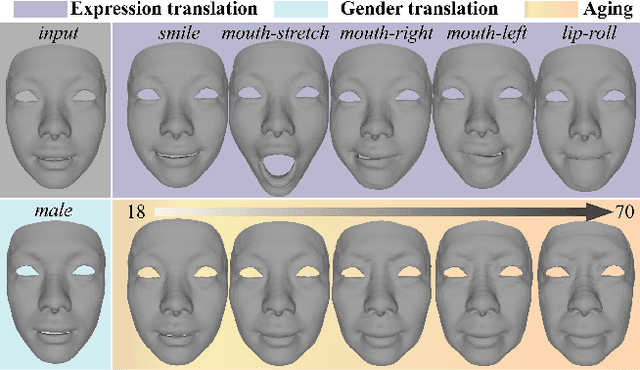


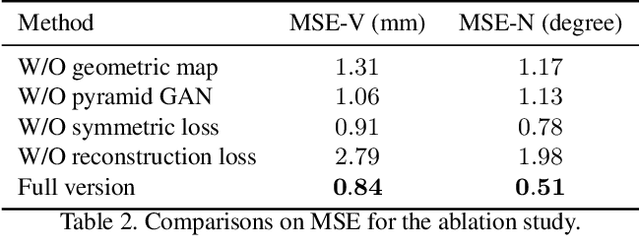
Abstract:While impressive progress has recently been made in image-oriented facial attribute translation, shape-oriented 3D facial attribute translation remains an unsolved issue. This is primarily limited by the lack of 3D generative models and ineffective usage of 3D facial data. We propose a learning framework for 3D facial attribute translation to relieve these limitations. Firstly, we customize a novel geometric map for 3D shape representation and embed it in an end-to-end generative adversarial network. The geometric map represents 3D shapes symmetrically on a square image grid, while preserving the neighboring relationship of 3D vertices in a local least-square sense. This enables effective learning for the latent representation of data with different attributes. Secondly, we employ a unified and unpaired learning framework for multi-domain attribute translation. It not only makes effective usage of data correlation from multiple domains, but also mitigates the constraint for hardly accessible paired data. Finally, we propose a hierarchical architecture for the discriminator to guarantee robust results against both global and local artifacts. We conduct extensive experiments to demonstrate the advantage of the proposed framework over the state-of-the-art in generating high-fidelity facial shapes. Given an input 3D facial shape, the proposed framework is able to synthesize novel shapes of different attributes, which covers some downstream applications, such as expression transfer, gender translation, and aging. Code at https://github.com/NaughtyZZ/3D_facial_shape_attribute_translation_ssgmap.
Pose-aware Attention Network for Flexible Motion Retargeting by Body Part
Jun 13, 2023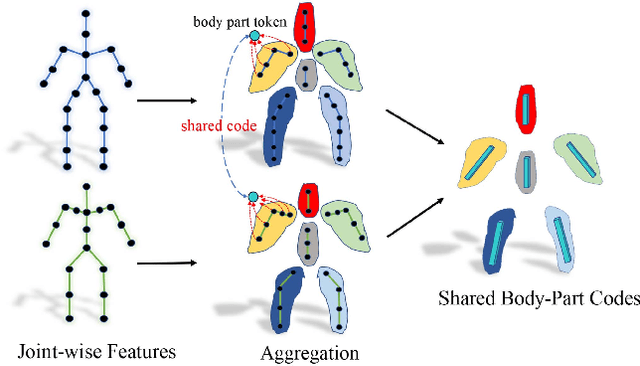
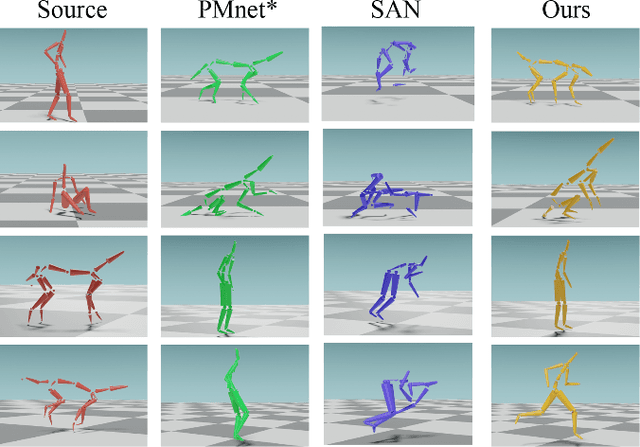
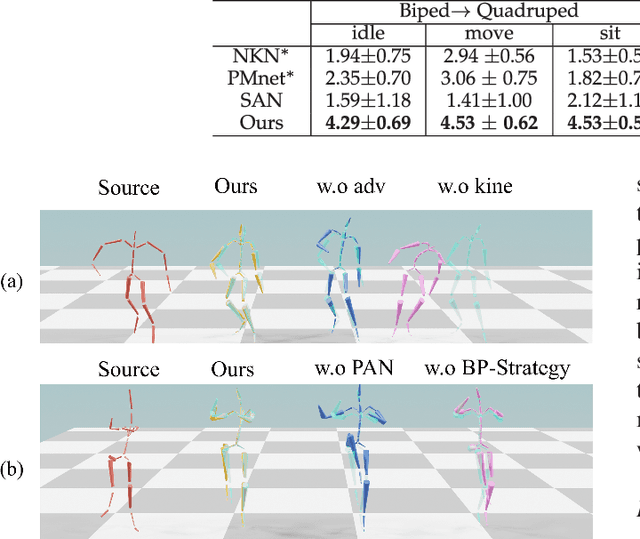
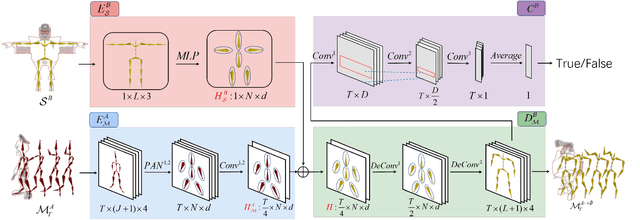
Abstract:Motion retargeting is a fundamental problem in computer graphics and computer vision. Existing approaches usually have many strict requirements, such as the source-target skeletons needing to have the same number of joints or share the same topology. To tackle this problem, we note that skeletons with different structure may have some common body parts despite the differences in joint numbers. Following this observation, we propose a novel, flexible motion retargeting framework. The key idea of our method is to regard the body part as the basic retargeting unit rather than directly retargeting the whole body motion. To enhance the spatial modeling capability of the motion encoder, we introduce a pose-aware attention network (PAN) in the motion encoding phase. The PAN is pose-aware since it can dynamically predict the joint weights within each body part based on the input pose, and then construct a shared latent space for each body part by feature pooling. Extensive experiments show that our approach can generate better motion retargeting results both qualitatively and quantitatively than state-of-the-art methods. Moreover, we also show that our framework can generate reasonable results even for a more challenging retargeting scenario, like retargeting between bipedal and quadrupedal skeletons because of the body part retargeting strategy and PAN. Our code is publicly available.
Spatial-Temporal Gating-Adjacency GCN for Human Motion Prediction
Mar 03, 2022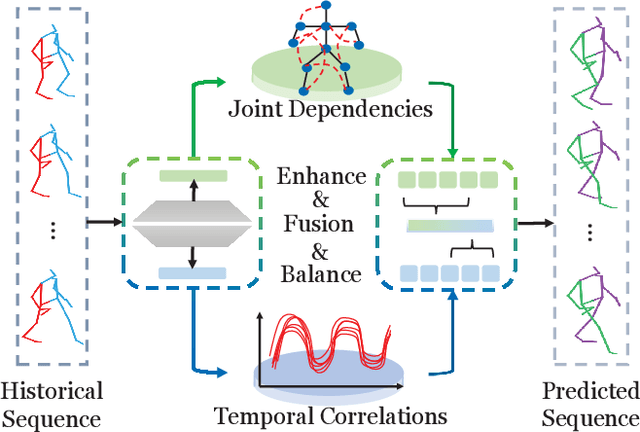
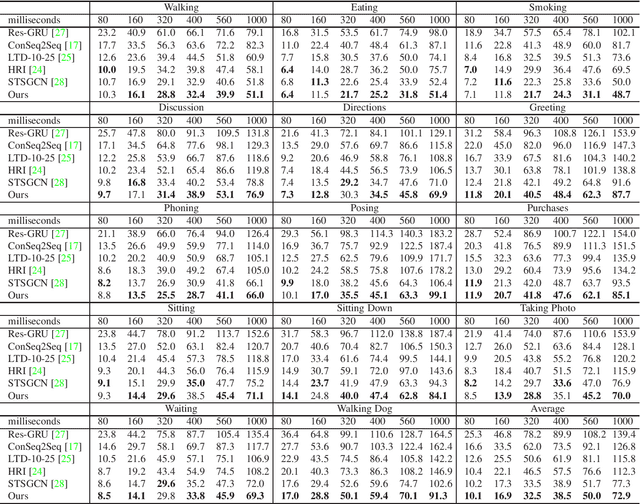
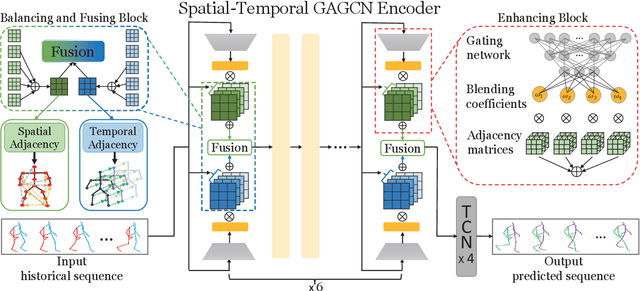
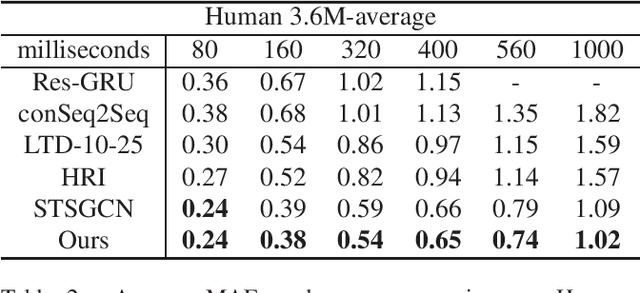
Abstract:Predicting future motion based on historical motion sequence is a fundamental problem in computer vision, and it has wide applications in autonomous driving and robotics. Some recent works have shown that Graph Convolutional Networks(GCN) are instrumental in modeling the relationship between different joints. However, considering the variants and diverse action types in human motion data, the cross-dependency of the spatial-temporal relationships will be difficult to depict due to the decoupled modeling strategy, which may also exacerbate the problem of insufficient generalization. Therefore, we propose the Spatial-Temporal Gating-Adjacency GCN(GAGCN) to learn the complex spatial-temporal dependencies over diverse action types. Specifically, we adopt gating networks to enhance the generalization of GCN via the trainable adaptive adjacency matrix obtained by blending the candidate spatial-temporal adjacency matrices. Moreover, GAGCN addresses the cross-dependency of space and time by balancing the weights of spatial-temporal modeling and fusing the decoupled spatial-temporal features. Extensive experiments on Human 3.6M, AMASS, and 3DPW demonstrate that GAGCN achieves state-of-the-art performance in both short-term and long-term predictions. Our code will be released in the future.
 Add to Chrome
Add to Chrome Add to Firefox
Add to Firefox Add to Edge
Add to Edge